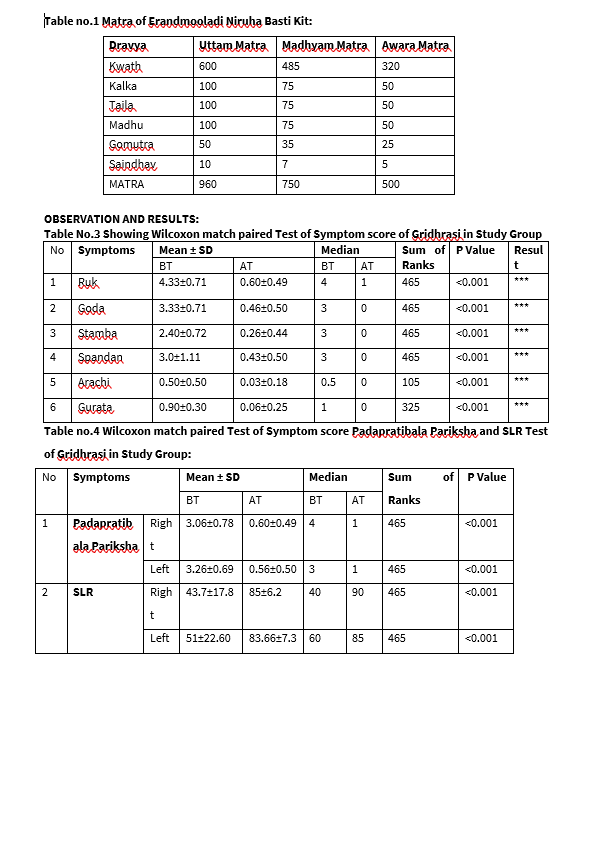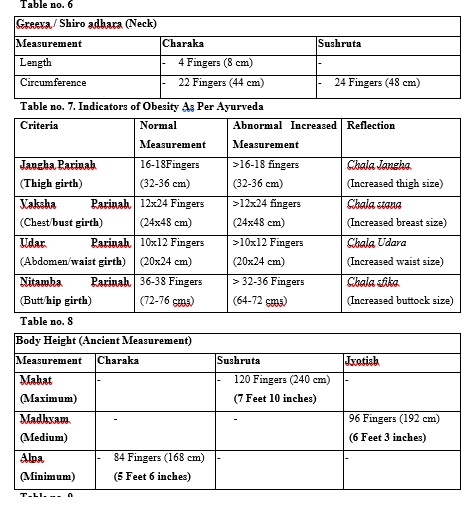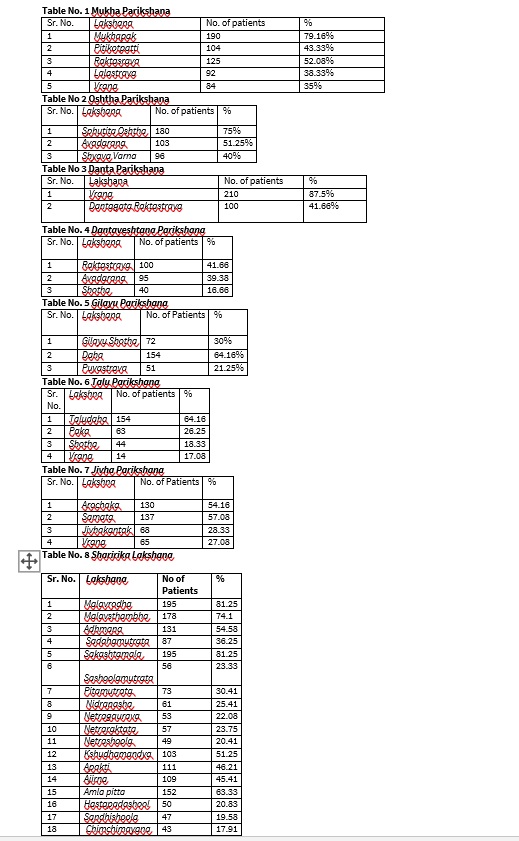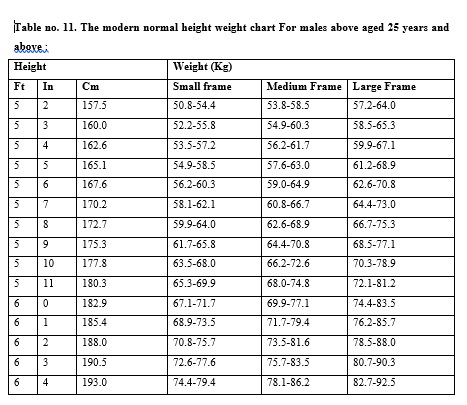Review Article
Year: 2020 |Volume: 1 | Issue: 1 |Pages: 32-39
Critical analysis of height weight ratio in Ayurvedic and Jyotish science W.S.R. to Obesity
About Author
Correspondence Address:
Dr. Subhash D. Waghe, M.D.(Roga Nidana) HOD – Dept. of Roga Nidana & Vikruti Vigyana Jupiter Ayurvedic College, Nagpur – 441 108 E-mail – carenidan@rediffmail.com (contact no. 7038000648)
Date of Acceptance: 2020-04-17
Date of Publication:2020-05-19
Article-ID:IJIM_6_05_20 http://ijim.co.in
Source of Support: NIL
Conflict of Interest: NIL
How To Cite This Article: Waghe Subhash D, Rajyalakshmi Rao Y.V, Savane Nitin V. Critical analysis of height weight ratio in Ayurvedic and Jyotish science W.S.R. to Obesity Int. J Ind. Med. 2020;1(1):32-39.
Abstract
Body Mass Index (BMI) is the important clinical tool to assess the risk of obesity. The BMI is increasingly used in clinical practice of modern era for risk assessment as well as for preventive measures in the form of healthy diet and lifestyle. The BMI is calculated from the measuring parameters like height and weight. The modern height and weight ratio is very well documented for thin, medium and thick frames. The idea of BMI can be traced in ancient Indian medical science, Ayurveda. Acharya Charaka had given the normal body measurement in the vimansthana. The increase in these measurements indicates the deviation from normal anthropometric values. Acharya Charaka had also mentioned the clinical objective sign of obesity in the form of increase in size of breast, gluteus, abdomen, chest (chala sphik, chala nitamba, chala udara) etc. The exact measurement of weight of an individual is not given. Hence, for this purpose the help from contemporary Astrological science is taken as per the guidelines given by acharyas to develop the science. The weight of an individual is very well mentioned in Jyotish science as a part of normal samudrik laxanas to predict the fortune based on these normal body features. The height measurement of an individual at 25 years of age is taken from the Ayurvedic science whereas weight of an individual at 25 years of age is taken from the Indian Jyotish science and the BMI is decided on the basis of these measurements. It is observed and concluded that these findings matches with the modern measurements.
Keywords: Pramana, Aayam, Vistar, Deergha, Parinah, Angul, measurement
Introduction
‘Pramana’ is one of the body parameter which needs to be examined under ‘Ayu laxanas’ (body characteristics) for assessment of strength of the body as well as for futuristic outcome of health and wellbeing. These body characteristics are used to predict the future outcome of health, education, and career and socio economic status. Persons having proportionate body are endowed with long life span, strength, Oja, happiness, luxury, wealth and other desired things. In contrast to this persons having more or less proportionate body are devoid of above benefits.1,2 Body Mass Index (BMI) is the important clinical tool to assess the risk of obesity, dislipidemia, metabolic syndrome, diabetes and Ischemic heart diseases. The BMI is increasingly used in clinical practice of modern era for risk assessment as well as for preventive measures in the form of healthy diet and lifestyle. The BMI is calculated from the measuring parameters like height and weight. The modern height and weight ratio is very well documented for thin, medium and thick frames. The idea of BMI can be traced in ancient Indian medical science, Ayurveda. Acharya Charaka had given the normal body measurement in the vimansthana. The increase in these measurements indicates the deviation from normal anthropometric values. Acharya Charaka had also mentioned the clinical objective sign of obesity in the form of increase in size of breast, gluteus, abdomen, chest (chala sphik, chala nitamba, chala udara) etc. Whereas the height of an individual at the age of 25 is very well mentioned in Ayurvedic science, the exact measurement of weight of an individual is not given. Hence, for this purpose the help from contemporary Astrological science is taken as per the guidelines given by acharyas to develop the science.
The weight of an individual is very well mentioned in Jyotish science as a part of normal samudrik laxanas to predict the fortune based on these normal body features. The height measurement of an individual at 25 years of age is taken from the Ayurvedic science whereas weight of an individual at 25 years of age is taken from the Indian Jyotish science and the BMI is decided on the basis of these measurements
Material & Method
Literary analytical method of research was adopted in the present study. Critical and comparative study of Ayurvedic literature and Jyotish science literature was done to come to logical conclusion.
Review of Ayurvedic & Jyotish Literature
Clinical Syndrome of Obesity [3]
1. Chala sfika – Increased gleutal mass
2. Chala Udara – Pendulous abdomen
3. Chala stana – Increased breast size
4. Ayatha Upachaya – Disproportionate nutrition
5. Ayatha Utsah – Lack of energy and enthusiasm
6. Kshudra Shwas – Exertinal dyspnoea
7. Pipasa – Polydipsia
8. Kshuda – Polyphagia
9. Sweda – Hyperhidrosis
10. Gatra Daurgandhya – Bromhidrosis
11. Krathan – Snoring
12. Gatra Sad – Lethargy
13. Gadgad dhwani – Soft voice
14. Swakriya Asamartha – Lack of activities
15. Alpa Vyaway – Decreased sexual performance
Out of these features, the objective signs like Increased gleutal mass (Chala sfika), Pendulous abdomen (Chala Udara), Increased breast size (Chala stana), Disproportionate nutrition (Ayatha Upachaya) indicates the deviation from the normal measurement. The normal measurements of these structures are given by acharya Charaka in the Vimansthana.
What is Pramana ?
As per Ayurveda, the measurement of length (Aayam) breadth (Vistar) and depth/height (Utsedh) of the body refers to the ‘Praman’.[4] As per Jyotish science, measurement of the body from base of the feet to the head, is referred as “Praman”. Some call it as the ‘Aayam’. [5]
So by definition it refers to the height of the individual.
What To Measure ?
Ayurvedic science suggests to measure following components of measurement]:
- Aayama (Length)
- Vistar (Breadth)
- Utsedha (Height)
- Parinaha (Circumference) [6]
What is Length (Aayama) ?
The vertical distance from base to the roof, is referred as “Aayam (Length)”. The length of the person is measured from the base of the feet to the head. [7]
What is Circumference (Parinaha) ?
Parinaha is the round distance between the two knee joints when one is seated in Padmasana. [8]
How To Measure (Mapan) ?
The various measurements should be measured in terms of fingers (Angul). For this purpose the examiner, should use his fingers to measure the various distances. [9] In ancient times, the tool used to measure the length, breadth, circumference etc was fingers. For long time in modern medicine also, this measurement was used to indicate organomegaly (for e.g. spleeno or hepatomegaly),dilatation of the uterus during labour. Now, it is replaced by modern universal SI units like millimeter, centimeter, meter etc.
Why The Examination of Measurement is done ?
To examine the longevity of the individual, Praman Pariksha is advised in the science. [10] The person having normal measurements are endowed with longevity, physical strength, immunity, happiness, luxary, wealth and other desired things. Those having short or long body than normal are devoid of above said virtues. [11]
At Which Age The Pramana Should Be Examined
As per acharya Sushruta, the Pramana Pariksha should be performed in male individual at the age of 25 years whereas in case of female it should be done at the age of 16 years to diagnose their ‘Dhatu Sarata’ as at this age all their dhatus gets matured and well formed. [12] These body features should be seen in the female of 20 years and male of 25 years. [13]
Jyotish science had given the upper limit of the ideal body features to be observed in individuals which corresponds to age of complete maturation. From Jyotish science point of view the age of complete maturation for female is 20 years and for male is 25 years.
Types of Measurements[14]
There are three types of measurements as follows :
- Mahat (Maximum)
- Madhyam (Medium)
- Alpa (Minimum)
Normal Body Measurements
- Thighs -The thighs are 18 fingers long and 16 fingers in circumference [15]
- Lumber -The lumbar is 16 fingers broad. The lumbar is 18 fingers broad. [16]
- Abdomen -The abdomen is 10 x 12 fingers broad. [17]
- Neck -The neck circumference is 24 fingers. [18]
Normal Height of The Human Beings
The Mahat (Maximum) height as per Sushruta is 120 Fingers (240 cm or 7 Feet 10 inches)
The Madhyam (Medium) height as per Jyotish science is 96 Fingers (192 cm or 6 Feet 3 inches)
The Alpa (Minimum) height as per Charaka is 84 Fingers (168 cm or 5Feet 6 inches) [19-22]
What is Weight (Mana) ?
The As like the medicines such as Manjishta etc are weighed, the human beings are also weighed. Since this process involves uplifting (Ut nayan) of the subject, hence called as the “Unman” [N.S.S. 2/20]
How Weight Is Measured ?
If the individual is immersed in full water pot/tank, then the amount of water displaced outside the pot/tank is the weight of the individual in liquid measurement called ‘Drona’[23] [1 Drona = 12 Kg 22 gm]
Importance of Weight
The persons having appropriate weight are happy and long lived whereas those having less or over weight than prescribed are unhappy. [24]
The quantity of medicines can be measured without the weights.
Height & Weight Ratio As Per Ayurveda
As per Ayurvedic acharyas, the maximum height of 25 years male is 120 fingers, nearly corresponding to 240 cm, i.e. 7 feet 10 inches. The medium height is 96 fingers, nearly corresponding to 192 cm, i.e. 6 feet 3 inches and the minimum height is 84 fingers corresponding to 168 cm, i.e. 5 feet 6 inches. This was the average height in that era, [25]
The person having weight equal to 1 & ½ Bhara (144 Kg) is a King like. The person having weight equal to 1 Bhara (96 Kg) is rich. The person having weight equal to ½ Bhara (48 Kg) is happy . [1 Bhara = 96 Kg ] [26]
This weighing standard was according to the social structure present in ancient era. For the height of 120 fingers (7 feet 1 inches) ancient ideal weight was 144 Kg.
For the height of 96 fingers (6 feet 3 inches) ancient ideal weight was 96 Kg.
For the height of 84 fingers (5 feet 6 inches) ancient ideal weight was 48 Kg.
Importance: Persons having proportionate body are endowed with long life span and abundant wealth. The moderately long have moderate life span and moderate wealth whereas short built have short life span and less wealth. [27]
Discussion
The BMI is calculated as Weight (Kg) / Height (m)2. Body Mass Index (BMI) is the important clinical tool to assess the risk of obesity, dislipidemia, metabolic syndrome, diabetes and Ischemic heart diseases. The BMI is increasingly used in clinical practice of modern era for risk assessment as well as for preventive measures in the form of healthy diet and lifestyle. The BMI of 18.5 to 25 is considered as Normal weight. The BMI of 25 to 30 is considered as overweight. The BMI of 30 to 35 is considered as Class I obesity. The BMI of 35 to 40 is considered as Class II obesity. The BMI of 40 =/> is considered as Class II obesity. The objective signs of obesity as per Ayurveda are - Increased gluteal mass (Chala sfika), Pendulous abdomen (Chala Udara), Increased breast size (Chala stana), Disproportionate nutrition (Ayatha Upachaya) indicates the deviation from the normal measurement. As per Ayurvedic acharyas, the maximum height of 25 years male is 120 fingers, nearly corresponding to 240 cm, i.e. 7 feet 10 inches. The medium height is 96 fingers, nearly corresponding to 192 cm, i.e. 6 feet 3 inches and the minimum height is 84 fingers corresponding to 168 cm, i.e. 5 feet 6 inches. This was the average height in that era. As per Jyotish acharyas, the person having weight equal to 1 & ½ Bhara (144 Kg) is a King like. The person having weight equal to 1 Bhara (96 Kg) is rich. The person having weight equal to ½ Bhara (48 Kg) is happy .This weighing standard was according to the social structure present in ancient era. For the height of 120 fingers (7 feet 1 inches) ancient ideal weight was 144 Kg. For the height of 96 fingers (6 feet 3 inches) ancient ideal weight was 96 Kg. For the height of 84 fingers (5 feet 6 inches) ancient ideal weight was 48 Kg.
Discussion on Result:
1. There is similarity in minimum measurement of height of an individual in both Ayurvedic as well as Jyotish science.
2. As per Ayurvedic acharyas, the maximum height (mahat) of 25 years male is 120 fingers, nearly corresponding to 240 cm , i.e. 7 feet 10 inches. The medium (madhyam) height is 96 fingers, nearly corresponding to 192 cm , i.e. 6 feet 3 inches and the minimum height (heena) is 84 fingers corresponding to 168 cm , i.e. 5 feet 6 inches.
3. The maximum (mahat) weight of 25 years male in ancient science is 1 & ½ Bhara (144 Kg). The medium weight (madhyam) is equal to 1 Bhara (96 Kg). The minimum weight (heena) is equal to ½ Bhara (48 Kg).
4. For the height of 120 fingers (7 feet 1 inches), the ancient ideal weight was 144 Kg. For the height of 96 fingers (6 feet 3 inches) ancient ideal weight was 96 Kg. And for the height of 84 fingers (5 feet 6 inches) ancient ideal weight was 48 Kg.
5. The BMI for Mahata praman Sharir (Maximum/thick built) of ancient era is 25Kg/m² which is normal.
6. The BMI for Madhyam praman Sharir (Medium built) of ancient era is 26 Kg/m² which is also almost normal.
7. The BMI for Heena praman Sharir (Minimum/thin built) of ancient era is 17Kg/m² which is also subnormal indicating thinness. 8. The Ayurvedokta BMI measurements almost matches with the BMI measurements of modern era except for thin built individual.
Conclusion
1. The critical comparison of Ayurvedic and Jyotish shastrokta, Pramanas, in the observation showed marked similarities between them.
2. The Ayurvedokta BMI measurements almost matches with the BMI measurements of modern era except for thin built individual.
3. The BMI can be used as a clinical tool assess the risk of obesity (Sthaulya), dislipidemia, metabolic syndrome, diabetes (Prameha), atherosclerosis (Dhamani Pratichaya) and Ischemic heart diseases.
4. The future outcome of health and fortune can very well be predicted from the assessment of Ayurvedokta and Jyotish shastrokta Praman Pariksha.
5. The persons having proportionate body are immune to the diseases and have good fortune.
References
value="
- Vd. Harichandra Kushwah, Charak Samhita; Viman Sthan 6/117 hindi translation, Published by Chaukhamba Orientalia, Gopal Mandir lane,Varanasi-221001, 2011;p 453.
- Vd. Atrideva, Sushrut Samhita of achaarya Sushruta, Sutrasthan 35/14-15, hindi translation, 5th edition, published by Motilal Banarasidas, Jawahar Nagar, Banglo rd, New Delhi -110 007,1975; p213.
- Vd. Harichandra Kushwah, Charak Samhita; sutra Sthan 21/9 hindi translation, Published by Chaukhamba Orientalia, Gopal Mandir lane,Varanasi-221001, 2011;p 231.
- Vd. Harichandra Kushwah, Charak Samhita; Viman Sthan 8/117 hindi translation, Published by Chaukhamba Orientalia, Gopal Mandir lane,Varanasi-221001, 2011;p 475.
- Abhay Katyayan, editor, Nrusti Samudrik Lakshan Shastra of acharya Jagatdev; Sha. 2/24. hindi translation, First edition, published by Chaukhamba Surbharati, Gopal Mandir lane, Varanasi-221001,2008; p 76.
- Vd. Harichandra Kushwah, Charak Samhita; Viman Sthan 8/117 hindi translation, Published by Chaukhamba Orientalia, Gopal Mandir lane,Varanasi-221001, 2011;p 475.
- Abhay Katyayan, editor, Nrusti Samudrik Lakshan Shastra of acharya Jagatdev; Sha. 2/24. hindi translation, First edition, published by Chaukhamba Surbharati, Gopal Mandir lane, Varanasi-221001,2008; p 76.
- Abhay Katyayan, editor, Nrusti Samudrik Lakshan Shastra of acharya Jagatdev; Sha. 2/34. hindi translation, First edition, published by Chaukhamba Surbharati, Gopal Mandir lane, Varanasi-221001,2008; p 78.
- Abhay Katyayan, editor, Nrusti Samudrik Lakshan Shastra of acharya Jagatdev; Sha. 2/31. hindi translation, First edition, published by Chaukhamba Surbharati, Gopal Mandir lane, Varanasi-221001,2008; p 78.
- Vd. Atrideva, Sushrut Samhita of acharya Sushruta, Sutrasthan 35/14-15, hindi translation, 5th edition, published by Motilal Banarasidas, Jawahar Nagar, Banglo rd, New Delhi -110 007,1975; p213
- Vd. Harichandra Kushwah, Charak Samhita; Viman Sthan 8/117 hindi translation, Published by Chaukhamba Orientalia, Gopal Mandir lane,Varanasi-221001, 2011;p 475
- Vd. Atrideva, Sushrut Samhita of acharya Sushruta, Sutrasthan 35/13, hindi translation, 5th edition, published by Motilal Banarasidas, Jawahar Nagar, Banglo rd, New Delhi -110 007,1975; p213
- Dr. Sureshchandra Mishra, Brihat Samhita of acharya Varaha Mihir, chapter 67/107 hindi translation, reprint, published by Ranjan Publications, 16, Ansari Road, Daryaganj, Delhi-110002. 2005; 575
- Vd. Harichandra Kushwah, Charak Samhita; indriya Sthan 7/8 hindi translation, Published by Chaukhamba Orientalia, Gopal Mandir lane,Varanasi-221001, 2011;p 521
- Vd. Harichandra Kushwah, Charak Samhita; Viman Sthan 8/117 hindi translation, Published by Chaukhamba Orientalia, Gopal Mandir lane,Varanasi-221001, 2011;p 475
- Vd. Atrideva, Sushrut Samhita of acharya Sushruta, Sutrasthan 35/14-15, hindi translation, 5th edition, published by Motilal Banarasidas, Jawahar Nagar, Banglo rd, New Delhi -110 007,1975; p213
- Vd. Harichandra Kushwah, Charak Samhita; Viman Sthan 8/117 hindi translation, Published by Chaukhamba Orientalia, Gopal Mandir lane,Varanasi-221001, 2011;p 475
- Vd. Atrideva, Sushrut Samhita of acharya Sushruta, Sutrasthan 35/12, hindi translation, 5th edition, published by Motilal Banarasidas, Jawahar Nagar, Banglo rd, New Delhi -110 007,1975; p213.
- Abhay Katyayan, editor, Nrusti Samudrik Lakshan Shastra of acharya Jagatdev; Sha. 2/25. hindi translation, First edition, published by Chaukhamba Surbharati, Gopal Mandir lane, Varanasi-221001,2008; p 76.
- Dr. Sureshchandra Mishra, Brihat Samhita of acharya Varaha Mihir, chapter 67/105 hindi translation, reprint, published by Ranjan Publications, 16, Ansari Road, Daryaganj, Delhi-110002. 2005; 575.
- Vd. Harichandra Kushwah, Charak Samhita; Viman Sthan 8/117 hindi translation, Published by Chaukhamba Orientalia, Gopal Mandir lane,Varanasi-221001, 2011;p 475.
- Vd. Atrideva, Sushrut Samhita of acharya Sushruta, Sutrasthan 35/12, hindi translation, 5th edition, published by Motilal Banarasidas, Jawahar Nagar, Banglo rd, New Delhi -110 007,1975; p213.
- Abhay Katyayan, editor, Nrusti Samudrik Lakshan Shastra of acharya Jagatdev; Sha. 2/33. hindi translation, First edition, published by Chaukhamba Surbharati, Gopal Mandir lane, Varanasi-221001,2008; p 78.
- Abhay Katyayan, editor, Nrusti Samudrik Lakshan Shastra of acharya Jagatdev; Sha. 2/34. hindi translation, First edition, published by Chaukhamba Surbharati, Gopal Mandir lane, Varanasi-221001,2008; p 78.
- . Vd. Atrideva, Sushrut Samhita of acharya Sushruta, Sutrasthan 35/12-13, hindi translation, 5th edition, published by Motilal Banarasidas, Jawahar Nagar, Banglo rd, New Delhi -110 007,1975; p213
- Dr. Sureshchandra Mishra, Brihat Samhita of acharya Varaha Mihir, chapter 67/105 hindi translation, reprint, published by Ranjan Publications, 16, Ansari Road, Daryaganj, Delhi-110002. 2005; 575
- Vd. Atrideva, Sushrut Samhita of acharya Sushruta, Sutrasthan 35/14-15, hindi translation, 5th edition, published by Motilal Banarasidas, Jawahar Nagar, Banglo rd, New Delhi -110 007,1975; p213.
"





